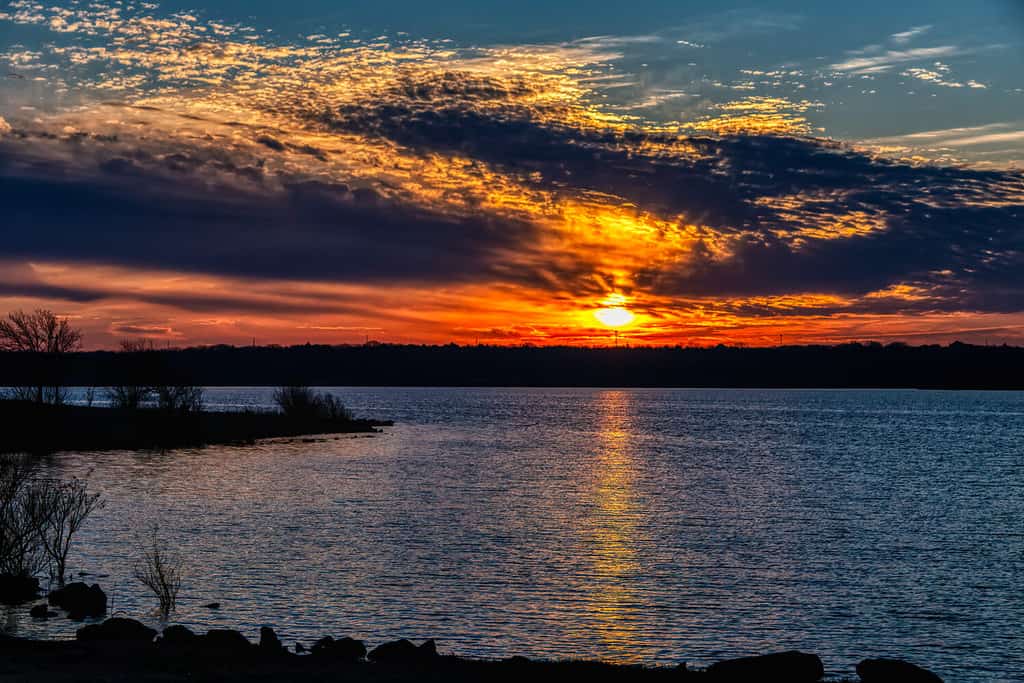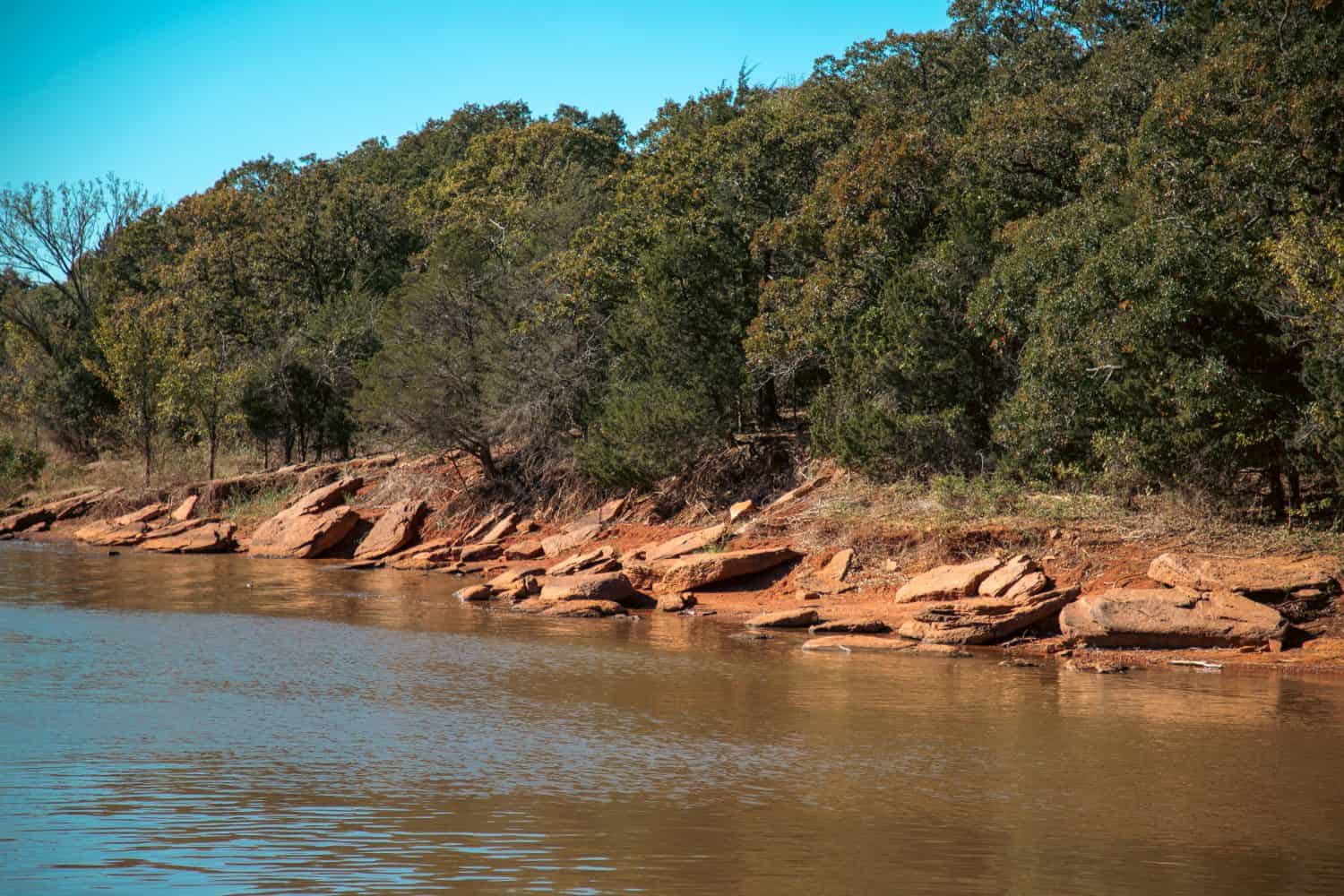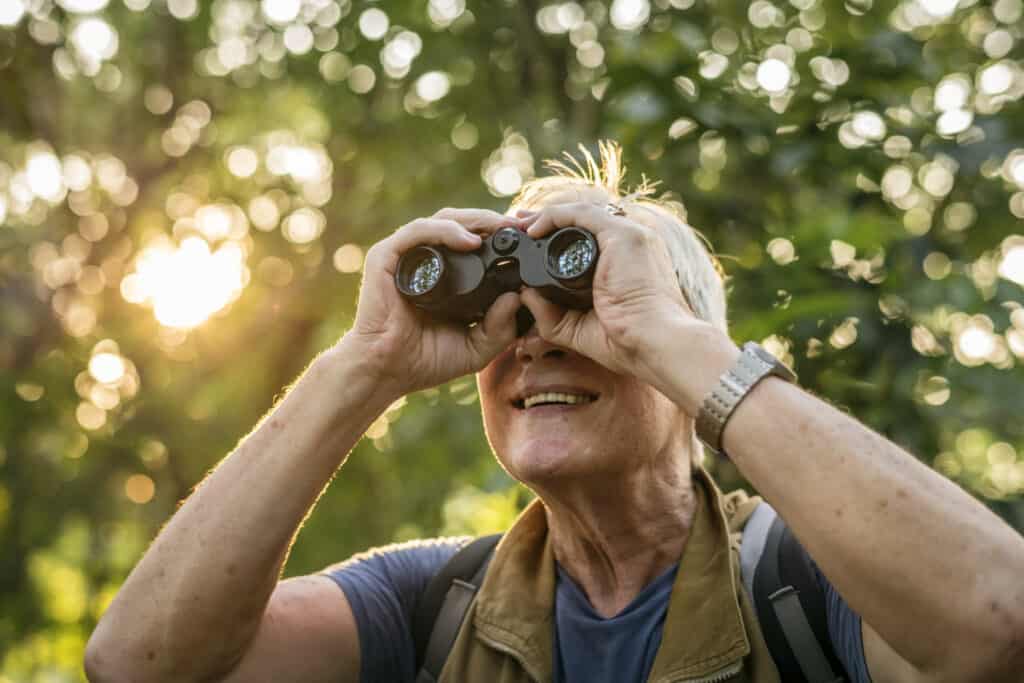Arcadia Lake ranks as one of the smaller lakes in Oklahoma, but it is an absolute favorite for many people living in the Oklahoma City metropolitan area and beyond. The lake draws more than half a million visitors each year, many from less than 30 miles away. Managed by the City of Edmond and constructed by the U.S. Army Corps of Engineers, this scenic reservoir lies just outside the metro. It provides a haven for wildlife and all sorts of recreational opportunities just a short drive from the bustle of the city.
How Deep Is Arcadia Lake?

A relatively shallow reservoir, Arcadia Lake has a maximum depth of 47.8 feet. According to the Oklahoma Water Resources Board, the lake provides 25.6 miles of shoreline. The surface area of the lake, at around 1,820 acres, pales in comparison to some of Oklahoma’s larger reservoirs, such as Lake Eufaula. But its proximity to Oklahoma City and the metropolitan area makes it a popular destination despite its small size.
Where Is Arcadia Lake?
Arcadia Lake lies just five miles east of Edmond, Oklahoma, off Historic Route 66. Named for the tiny nearby town of Arcadia, Oklahoma, this reservoir is just miles away from Oklahoma City. Bordered by old Route 66 on the north, Interstate 44 on the south, and Interstate 35 on the west, visitors can easily make their way to this scenic oasis from all directions.
When Did Arcadia Lake Open?

Arcadia Lake is a relatively young lake that opened in 1986.
©Robert Protus/Shutterstock.com
According to the U.S. Army Corps of Engineers, Arcadia Lake became operational in 1986. However, the conservation pool did not finish filling until the spring of 1987. The lake resulted from damming the Deep Fork River, a tributary of the North Canadian River. Construction began on the dam in 1980.
What Parks Can Visitors Explore?

The parks at Arcadia Lake offer miles of trails and beautiful shorelines.
©Brad Remy/Shutterstock.com
The City of Edmond operates five parks around Arcadia Lake. These include Spring Creek Park, Central State Park, Scissortail Campground, Edmond Park, and Carl Reherman Park. The city also manages hiking trails and other recreational amenities. Visitors to the parks who do not have an annual pass must pay a small daily entry fee or a camping fee if they will be staying overnight. Fees support the ongoing maintenance of the parks and facilities on the lake.
Recreational Opportunities

Swimming is not allowed at most of the Oklahoma City metropolitan lakes.
©Zoran Zeremski/Shutterstock.com
Visitors can enjoy many different recreational opportunities at Arcadia Lake. One of the most popular activities for Oklahoma City area residents is lake swimming. Oklahoma City has a few other lakes in the metropolitan area, including Lake Hefner, Lake Overholser, and Lake Stanley Draper. But each of these reservoirs prohibits swimming. Arcadia Lake is the closest lake where folks can spend a day on the beach and swim to their heart’s delight.
Other recreational offerings include disc golf and hiking on the various trails around the lake. Don’t miss the Teaching Trail, where folks can learn all about different trees and wildlife native to the area. Biking and equestrian trails also provide lots of fun and excitement for both locals and visitors from afar.
Overnight visitors can choose from RV and tent sites. Many come with full hook-ups. Boat ramps allow easy access to the water for fishing and skiing.
Fishing at Arcadia Lake

The dam at Arcadia Lake in Edmond, Oklahoma has long been a popular fishing location.
©OKJaguar, CC BY-SA 4.0, via Wikimedia Commons – Original / License
Folks love fishing at Arcadia Lake. The lake was well-stocked by the Oklahoma Department of Wildlife Conservation soon after it was built. They supplied the lake with a variety of fish, including largemouth bass, blue and channel catfish, bluegill, redear sunfish, and a hybrid fish known as saugeye.
Visitors can fish from the shoreline, from boats, or from docks in the parks. Spring Creek Park features an enclosed, heated, and fully accessible dock available to the public. Visitors must follow all rules and regulations and possess a valid fishing license if required.
Wildlife at Arcadia Lake

Birdwatching is a popular activity for visitors at the lake.
©iStock.com/:Rawpixel
As a working naturalist in Oklahoma, this author spent considerable time in the 1990s teaching children about the wildlife they might find at Arcadia Lake. The lake provides a wonderful natural setting within easy driving distance for schools in Edmond, Oklahoma City, and other cities in the sprawling metropolitan area.
In addition to the Teaching Trail, where kids can learn about native plants and animals, the parks at the lake included ponds for fishing clinics and pond biology classes. It also had open fields, bird blinds, and other spots for learning about wildlife. Many of the million or more visitors that visit the lake each year come from area schools.
Some of the many animals that people may see when visiting Arcadia Lake include birds of prey such as hawks and owls, wading shorebirds, migrating ducks and geese, and many other birds. Various snakes inhabit the area, including rat snakes, bull snakes, garter snakes, hognose snakes, various water snakes, and even venomous snakes such as copperheads, cottonmouths, and rattlesnakes. Large mammals include white-tailed deer, beavers, bobcats, foxes, and coyotes.
Many other species, including small mammals, lizards, amphibians, and more live in and around Arcadia Lake. Some might be easily seen while camping or on a hike. You might see evidence of others, in their prints, their scat, or their nests or burrows. Remember that the lake provides much-needed resources for animals whose habitats have degraded as the human population of the area has continued to expand. Treat animals with respect and avoid approaching wildlife too closely when visiting the lake.
The photo featured at the top of this post is © Robert Protus/Shutterstock.com
Thank you for reading! Have some feedback for us? Contact the AZ Animals editorial team.







